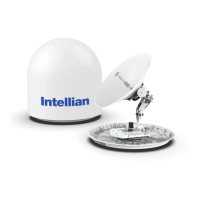
Do you have a question about the Intellian v100NX and is the answer not in the manual?
Defines WARNING, CAUTION, and NOTE statements for safety.
Provides essential safety guidelines for handling and storage.
Declares v100NX compliance with FCC regulations for Ku-band operation.
Declares conformity with EU Radio Equipment Directive (2014/53/EU).
Overview of the v100NX Ku-band VSAT maritime antenna system.
Highlights key features like RF performance, dual antenna support, and AptusNX.
Describes the antenna pedestal, dish, RF components, and radome protection.
Details the ACU's functions, front panel, and rear panel interfaces.
Provides detailed technical specifications and dimensions for the antenna.
Explains the correct positioning of the radome assembly relative to ship's heading.
Details recommended mast dimensions and design considerations for installation.
Specifies the required mounting hole pattern for the antenna base.
Outlines crucial steps before installation, including site selection.
Guides on choosing an optimal installation location for signal strength and clear view.
Emphasizes avoiding obstructions in the antenna's elevation range for optimal performance.
Provides guidance on preventing interference from radar and other sources.
Details safety measures related to RF radiation exposure during operation.
Covers considerations for selecting and preparing RF and gyrocompass cables.
Explains methods for routing cables on the mast, inside or outside.
Step-by-step instructions for safely unpacking the antenna from its shipping crate.
Procedures for detaching the antenna from the pallet and shipping brackets.
Guides on lifting and mounting the antenna onto the mast, ensuring correct orientation.
Instructions for applying waterproof foam to seal cable entry points.
Details the process of securing the radome to the mast using bolts and washers.
Explains how to connect the RF cable between the ACU and the antenna radome.
Describes how to access and verify the power switch inside the radome.
Advises on choosing a suitable location for installing the Antenna Control Unit (ACU).
Provides the physical dimensions of the ACU for installation planning.
Details how to mount the ACU, specifically using 19" rack mount brackets.
Illustrates basic and dual antenna system connection diagrams.
Shows the cabling for a standard single antenna setup with ACU and modem.
Depicts the connection setup for a dual antenna system with two antennas and ACUs.
Details rear panel connections for antenna, modem, and other peripherals.
Explains connecting the RF cable from the ACU's ANTENNA port to the radome.
Guides on connecting the RF and Ethernet cables between the ACU and the modem.
Describes connecting the ACU to a network switch router via Ethernet.
Covers connecting a gyrocompass for heading information via NMEA.
Provides detailed pinout information for various ACU connectors.
Instructions on how to connect to and access the AptusNX software interface.
Guides on configuring modem settings within the AptusNX software.
Initiates the guided setup process for antenna commissioning.
Configures the ship's heading device within the installation wizard.
Selects and configures the satellite modem type in the installation wizard.
Sets the bow offset by selecting a trackable satellite during the wizard.
Defines blockage zones to prevent personnel exposure to transmit power.
Selects the satellite for the antenna to track.
Performs RF cable calibration to ensure consistent signal levels.
Conducts tests to confirm antenna performance and operation status.
Displays and saves the configuration and test results.
Describes the layout and functions of the ACU's front panel controls and indicators.
Explains the information displayed on the ACU's screen and the meaning of status indicators.
Details the sequence of operations displayed on the ACU during system startup.
Guides on executing and interpreting antenna diagnosis tests.
Explains how to check current firmware versions and perform upgrades.
Step-by-step guide for manually upgrading the antenna firmware.
Details the process for upgrading the iARM module firmware.
Describes saving settings and rebooting the iARM module.
Explains how to manage the satellite library for tracking.
Introduces the spectrum analyzer for measuring RF signal frequencies.
Provides procedures for running antenna diagnosis tests and viewing results.
Explains how to view and download antenna log data for monitoring.
Covers viewing and filtering event logs based on severity, category, and time.
Provides access to manuals, support desk contact, and FAQs.
Configures ship information, GPS position, and blockage zones.
Sets antenna position, search parameters, and sensor biases.
Configures parameters for tracking a specific satellite.
Sets up network parameters, including IP addresses and Wi-Fi.
Configures settings related to the satellite modem and BUC.
Configures SNMP settings for network monitoring.
Manages backup and restore operations for antenna and iARM settings.
Configures the dual antenna mediator function for seamless switching.
Lists detailed technical specifications for the antenna system and ACU.
Outlines the operational and survival specifications under various environmental conditions.
Details the product warranty terms and conditions.
Provides instructions for setting up and configuring a dual antenna system.
Explains how to assign primary and secondary roles to antennas in a dual system.
Describes how to monitor the status of a dual antenna system via AptusNX.